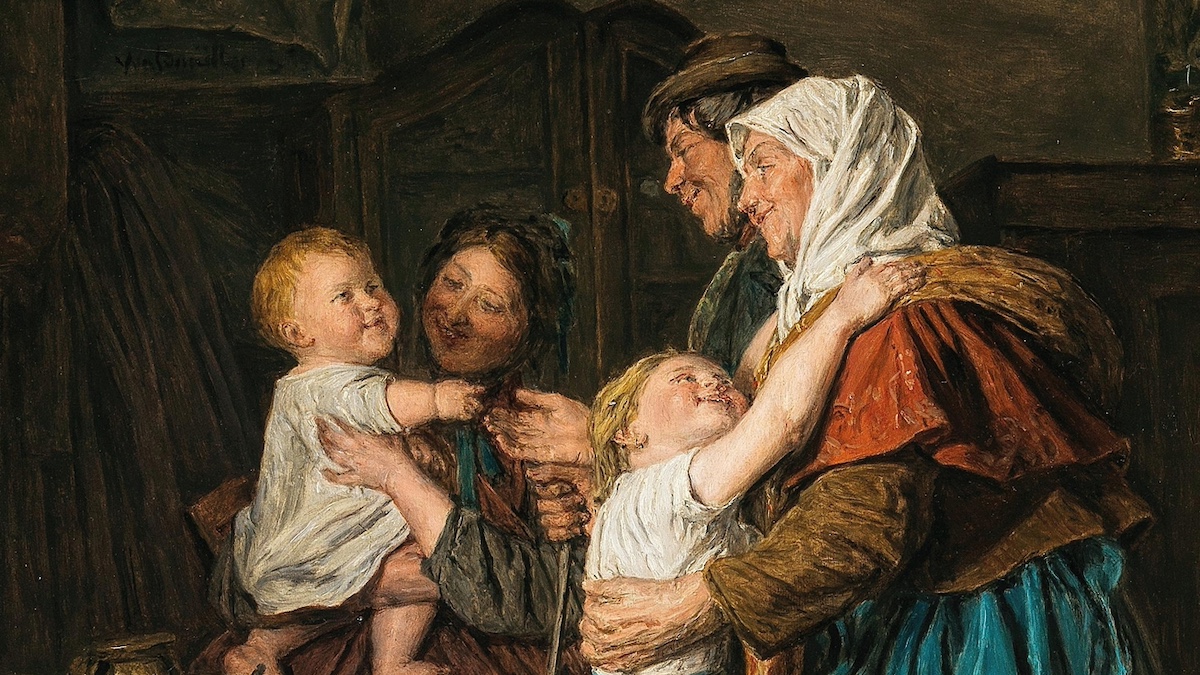In February, an elderly New Yorker had a medical emergency and was saved by an AI speaker.
This good news from the New York Post is bad news for the state of eldercare. With others expressing hope that similar devices will provide medical care and companionship for seniors, our reliance on AI is a grim reminder that we’re in the midst of an eldercare crisis.
The man, Doo Soo Yoo, was home alone when the speaker notified his care team that he went silent. His AI speakers was provided free of cost through a state grant looking to address the shortage of care workers and “skyrocketing isolation and depression.” Helpful as such devices may be, no machine can ever fulfil the need for human care.
To treat our elders with the reverence and dignity that they’re owed, families must overcome the unique sex-based challenges that men and women experience when fulfilling their caregiving duties. Meanwhile, our elected officials must reform social programs to create a family-friendly culture. These partnerships will replace the dystopian vision of AI in every home with one in which men like Doo Soo Yoo have someone by their side.
The Perfect Storm
In the not-so-distant past, Americans saw caring for the elderly as an obligation born out of reciprocity and reverence. As the late family historian Tamara Hareven observed in the Annual Review of Sociology, “In the regime of economic insecurity characteristic of the nineteenth century and the first part of [the twentieth] century, kin assistance was the only constant source of support.” In this more interdependent era, adult children needed their parents just as much as their parents needed them. What’s more, people also cared for senior citizens outside of their families. Hareven wrote that the boarding system was common for young couples seeking affordable rent, and the elderly rented out space “in exchange for money or assistance” and to “avert loneliness.”
Given the intergenerational ties among both kin and strangers, it’s no wonder that nineteenth-century Americans revered senior citizens. A study in the Journals of Gerontology analyzes key words used to describe the elderly across a 210-year period starting in 1810. During the nineteenth century, common words in newspapers, magazines, and books were those related to “kinship,” “love,” “honor,” and “veneration.” These words are fitting. Eldercare is a privilege that repays the elderly after their lifetime of service to their families and communities, and it’s a recognition that, because each person has inherent worth, everyone deserves care.
In our own time, economic, demographic, and cultural changes have created a perfect storm, demolishing the communal support once available to older Americans. After the United States industrialized, economic opportunities put geographic distance between parents and their adult children. The nuclear family replaced the multi-generational household, and senior citizens eventually became the main victims of the loneliness epidemic.
Smaller families and an aging population don’t help matters. Without intervention, by 2060 approximately one in four people will be over 65 years old. According to United Nations estimates, “almost one half of the world’s population” lives in a country with birth rates below the replacement rate. As life expectancy rises and populations age, there are fewer and fewer young people to provide care to the aging.
Even though most seniors prefer to age in place, their intense medical needs can make at-home care impractical. Today’s seniors benefit from life-extending modern medicine, but they are also suffering from neurodegenerative diseases such as Alzheimer’s at increasing rates. For seniors with particularly complex needs, institutional care might be the best option.
Families that are willing and able to provide at-home care still struggle to afford it. The average social security payment “will only cover approximately two-thirds of the cost of having a part-time [my emphasis] home health aide.” Seniors also rely on Medicaid (health insurance for low-income citizens) and Medicare (health insurance for citizens over 65). However, the benefits of these programs differ by state. They will often pay professionals to provide intermittent, home-based medical care, but they will not necessarily pay for help with daily tasks, such as cooking and bathing.
Meanwhile, caregivers are in a tricky position in relation to their own retirement. Those who leave the workforce to care for others put a pause on their Social Security contributions, and Congress isn’t exactly leaping into action to help.
The Second “Second Shift”
Women and men tend to experience the problems caused by aging populations, expensive care, and atomized societies differently. Since the 1980s, sociologists have documented working moms’ “second shift”: the 24.5 hours a week that they spend on childcare and household chores, in addition to their paid work. Members of “the sandwich generation” (adults who care for both aging parents and young children) often work yet another shift.
Research from the University of Michigan shows that the majority of sandwich generation caregivers are women, a finding that holds true for caregiving more generally. Providers of eldercare dedicate “an average of 3.6 hours” a day to the task. In other words, the combined eldercare, childcare, and household chores performed by the sandwich generation equal a full-time job. Although most sandwich generation caregivers also work outside the home, not all can continue their paid work. 2021 survey data indicates that one in five “employees have had to quit their job to care for a loved one,” and other research shows that women quit more often than men.
The demands of early motherhood often lead women to lean out of the workforce after the birth of a child. Later in life, women are usually the ones who lean out once again if someone else needs care. Families with both sons and daughters tend to look to daughters for caregiving. The American Sociological Association (ASA) published a strongly-worded article in 2014, titled “Daughters provide as much elderly parent care as they can, sons do as little as possible.” Dr. Darby Morhardt suggests that patterns in personality differences may play a role here. Whether due to nature, nurture, or a combination of the two, female caregivers “appear to be more concerned about the emotional well-being of people for whom they provide care,” and they “express [a] greater sense of responsibility towards family member[s],” accompanying a sense of “altruism and self-sacrifice.”
But eldercare can overwhelm women who go it alone. Meager tools and resources exist, and adults often refuse what little help there is. While children’s dependency is expected, elderly dependents often feel ashamed of the dependence on others—particularly in cultures that valorize autonomy. The elderly, for example, will often refrain from using a wheelchair or walker in public, even if they need it. Likewise, caregivers can feel uncomfortable in making decisions for their elderly loved ones. Caregivers might see an elderly family member as existing in a liminal space—somewhere between an adult who’s used to making choices independently and a dependent who needs help making choices. In the rare places where there’s financial support for eldercare, families must get past the sense that adult day care is patronizing (as evidenced by the many blog posts and articles on convincing reluctant seniors to go).
Many women spend most of their adult lives as caregivers, and they need men’s help. Eldercare is a group effort, and male-female solidarity is especially important in the absence of state support for caregivers.
Of Sons and Husbands
For men, who make up an estimated 39 percent of caregivers for the elderly, their sex-based challenges can leave them struggling in silence.
As Richard Reeves argued in Of Boys and Men, overemphasis on male privilege can sideline the discussion of legitimate problems faced by men. One of the ways that men are falling behind is their underrepresentation in what Reeves calls the HEAL professions (health, education, administration, and literacy). Men are hurt by this underrepresentation because they benefit from receiving care from other men. Reeves notes in Time that men might prefer same-sex help in personal care tasks like using the restroom, and a study in the journal The Gerontologist recommends adding male staff to nursing homes to address men’s dissatisfaction with these facilities.
When it comes to unpaid caregiving, men’s social ties (or lack thereof) determine how they give and receive care. Lois M. Collins notes that sons and husbands who act as caregivers need help, too, but they often hesitate to ask. Men are less likely than women to call on friends and family or to tell their employer about their caregiving role and how it might impact their work. For all their stoicism, “sons reported experiencing the ‘highest emotional and financial strain levels.’”
In The Atlantic, Chiara Dello Joio suggests another way that men’s social ties influence eldercare. Families have a “matrilineal advantage,” with children spending more time and having stronger bonds with maternal aunts, uncles, cousins, and grandparents. A study in Gerontology suggests that the matrilineal advantage influences eldercare. In a survey of married adults, responses “indicated that adult sons reported providing more support for their parents-in-law (i.e., wives’ parents) than adult daughters provided to their parents-in-law.” The matrilineal advantage could also leave men without the help they need when caring for their own parents, since they are less likely to have maintained strong ties with their extended family members.
Modernity has exacerbated the sex-based challenges of eldercare. The large extended families that once helped women fulfill their responsibilities no longer exist. In an atomized society, men hesitate to ask for help from those with whom they do not have strong bonds. But when men and women work together, their complementary skills ensure that seniors receive holistic care, or care that meets their physical and emotional needs.
Reframing care as a privilege, as an act of love, relies on a set of solutions ranging in complexity, from enlisting teenagers and developing apps to reforming Social Security and adopting multigenerational living.
Searching for Solutions
The forces that weakened family and community and spawned the eldercare crisis won’t go away overnight. Because making sweeping cultural changes is an uphill battle, what people must do to rebuild family and community might sound simplistic: Get married! Have bigger families! Join a bowling league!
So, instead of doing the slow, quiet, cultural work that will alleviate the root causes of seniors’ suffering, Western nations are foolishly rushing to apply a band-aid. Though historically assisted suicide was most often a response to physical pain, today patients are frequently responding to psychic pain when they seek so-called “death with dignity” or “medical aid in dying.” In countries and states where the practice is legal, “the dominant motivations for requesting euthanasia,” says medical ethicist Ezekiel Emanuel “are loss of autonomy and dignity, the inability to enjoy life and regular activities, or other mental illnesses, rather than physical pain.”
Ideally, caregivers would help seniors find new sources of joy when their declining health affects their favorite activities. Caregivers would challenge seniors’ self-conception as “burdens” and remind them that they’re entitled to care after spending most of their lives caring for others. By contrast, the assisted suicide regime offers seniors a cheap yet morally bankrupt solution. Assisted suicide treats the markers of old age—such as a decline in activity or loss of autonomy—as signs that a life is no longer worth living.
To respond effectively to the crisis in eldercare and affirm the dignity of seniors, we must draw on the respective strengths of the sexes while acknowledging how their differences lead to gaps in care. One form of partnership between men and women might involve wives leaning out at the beginning of their careers and husbands leaning out at the end. A woman might go part-time or exit the workforce altogether for five or ten years while her children are young. She could then re-enter the workforce when her children enter school. A man, meanwhile, might go part-time or retire five to ten years early to care for elderly relatives while his wife works.
In addition to Medicaid and Medicare reform, awarding social security credits for unpaid caregiving would make this coordination between men and women easier. A bill reintroduced by Connecticut’s Christopher Murphy in the U.S. Senate would allow caregivers to enjoy the same retirement benefits as those who work full-time. Changes like these would help men and women share in the rewards of a career and care, with neither feeling shortchanged by a trade-off between aspiration and duty.
Although technology should not be used to replace human connection, it can and should be harnessed to facilitate it. To forge social ties, a tech-savvy person might create an app that connects volunteers to nearby seniors who need care and companionship. Very few senior-specific apps exist. If it were sufficiently user-friendly, such an app could facilitate both in-person interactions and the analog communication that’s more familiar to seniors. The app would combine the features of apps like Taskrabbit and Ameelio. Nursing home or home health staff, family members, pastors, or social workers could register those in their care. Whether someone wants a pen pal, someone to talk to on the phone, or help around the house, this app would find people who are committed to sharing their time but don’t know who in their community needs assistance.
Another lifestyle change holds great promise, yet it goes against the very idea of the American Dream: the multi-generational household. A home of one’s own is a marker of affluence, and it can be difficult to let go of the illusion of self-sufficiency. In nations where people can live anywhere, a multigenerational household might violate a well-to-do family’s notions of privacy and privilege, even though the luxury of closing a door is, historically speaking, a fairly recent one. Yet the multigenerational household has so many benefits. It creates a continuum of care: grandparents and parents help care for young children, and then grown children care for parents and grandparents. Dependency slowly shifts from the young to the old, so recipients of care—who have likely looked after their caregivers at some point—don’t feel like a burden.
Although there is still much work to be done, solutions like these hold promise for addressing the eldercare crisis. Already, many quiet, everyday heroes are stepping up. I think, for example, of the shuttle driver I met who takes care of his grandmother because—despite the research on women as the default caregivers—none of her three daughters would.
We must work together to transform our culture. By changing policy, coordinating care with a spouse, or helping a neighbor in need, we can all help each other remember that showing love and gratitude to seniors is all of our responsibility.



